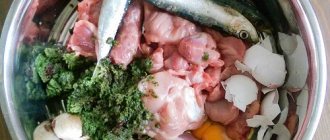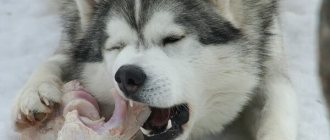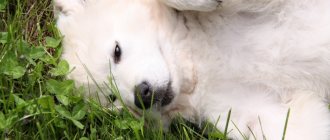What's better in natural conditions at home?
Some owners choose natural feeding for their pets, rightly believing that since the dog is a predator, it should eat meat with various additives, such as cereals, vegetables and herbs. But if you simply combine all this into a common pile in a dog’s bowl, without taking into account the nutritional value of the products and the presence of vitamins and minerals in them, then there will be little benefit for the animal from such food.
Many who feed their pets incorrectly do not even realize it. And those who guess, perhaps, would like to correct the situation, but do not know how to do it.
How to do it right
BARF system, developed back in 1993, can help dog owners in this case , in which the dog’s diet is based on feeding meat products. It is based on the principles of feeding predators in the wild, where they eat raw meat, bones, game entrails, fat, as well as eggs, herbs and roots.
Here is a table of the main natural food products for feeding dogs, used in the BARF diet:
- Raw meat : beef, horse meat, lamb, chicken, turkey, rabbit. In this case, the meat should have cartilage, veins and films.
- Bones : bird necks and heads (the beak must be removed), beef tails, large bones. IMPORTANT! Meat and bones should be in the diet in approximately equal quantities and should be fed to the dog raw.
- By-products : raw tripe, poultry giblets, trachea, lung, heart, liver, beef trimmings.
- Fish : Very good for dogs as a source of Omega-3 and phosphorus. But, despite the fact that BARF is a raw food feeding system, it should only be given to dogs in boiled form. In this case, it is better to feed your pets sea fish, such as pollock, hake, cod, and blue whiting.
- Vegetables . Give raw in any quantity: carrots, zucchini, pumpkin, broccoli and cauliflower, as well as bell peppers and cucumbers. Give raw, but in small quantities: white cabbage, tomatoes, green beans. According to the BARF system, all vegetables should be pureed, but you can also give them simply cut into small pieces.
- Greens : lettuce, parsley, nettle (boil with boiling water and cool before giving it), dandelion leaves, seaweed.
- Fruits and berries . Allowed: apples, pears, watermelon, blueberries, blueberries, lingonberries, banana.
- Dairy products . Healthy: cottage cheese, natural yogurt, kefir, yogurt.
- Eggs . No more than 1-2 times a week. They are given only raw, and only the yolk can be fed to dogs.
- Fats : olive, flaxseed or burdock oil, fish oil for dogs.
- Additives : seaweed, vitamins B, C and E, as well as bran.
How many times a day do you need
Usually it is customary to feed a dog 2 to 3 times a day, not more often. It makes no difference whether it is food or natural food.
The percentage of products for an adult dog should be as follows:
- meat - 60-70%
- vegetables and herbs - 15-20%
- eggs and sour milk - 15-20%
ATTENTION! For puppies, you need to change the proportions, while increasing the proportion of sour milk.
The daily feeding rate according to BARF should be:
- Adult : 2-3% of the animal’s weight.
- For working dogs, the diet should be increased by 5%,
- and for growing puppies - by 5-10%.
It is not necessary to follow this nutritional system exactly, but you can take some of its principles as the basis for your pet’s diet. Here are a few sample recipes for BARF, but you can, based on them, come up with your own versions of dishes for your pet.
- Beef trimmings, raw yolk, herbs, flaxseed oil.
- Chicken liver (boiled with boiling water), yogurt, olive oil, bran.
- Turkey meat, chicken necks, carrots, herbs, flaxseed oil.
- Low-fat cottage cheese, fresh grated carrots, curdled milk or yogurt, raw yolk.
- Boiled pollock or whiting, fresh cabbage, tomato, greens, raw yolk or boiled egg (both yolk and white), olive oil.
- Beef trimmings, raw grated pumpkin, egg, lingonberries.
- Cottage cheese mixed with kefir, grated apple, blueberries, raw yolk.
- Chicken necks, turkey, raw beef, grated carrots, vegetable oil.
- Beef trimmings, liver, bell pepper, vegetable oil.
- Chicken backs or wings, fresh cucumber, yogurt, vegetable oil.
ATTENTION! According to the BARF system, you should not feed dogs cereals, but if you do not strictly adhere to it, you can add a little boiled rice, buckwheat or oatmeal to your pet’s food.
Menu for the week
When a dog is fed natural food, it is especially important to correctly prepare its diet, not only the daily diet, but also the weekly menu. It should be borne in mind that the animal should receive not only healthy, but also varied food.
Here is a sample menu for a medium-sized dog weighing about 20 kg. For smaller and larger breeds, the amount of food should be increased according to the proportions. In this case, you should also take into account how busy the dog is with work or how active he is. For pets leading a “sofa-searching” lifestyle, this diet should be slightly reduced, and for working dogs – increased.
- Monday, Wednesday, Thursday, Saturday
Morning:chicken necks or backs (you can also grind turkey necks) - 300 g, organic yogurt (about a quarter glass) - pour it on top, fish oil - 0.5 teaspoon, vitamin E - give after meals 100 mg.
Evening:
meat and offal - 180 gr., vegetables - 120 gr., apple cider vinegar - 1 teaspoon, bio-yogurt, olive oil - 2 teaspoons, vitamins C and B1 - in tablets, according to the instructions for the preparations.
- Tuesday (fish day)
Breakfast:chicken necks, backs or ground turkey necks - 300 g, organic yogurt - pour on top, fish oil - 0.5 teaspoon, vitamin E - after meals 100 mg.
Dinner:
sea fish or minced fish - 250 gr. vegetables - 120 gr. egg yolk - 1 piece, raw, apple bite - 1 teaspoon, bio-yogurt, olive oil - 2 teaspoons,> vitamin C and vitamin B1 - give according to instructions.
- Friday (Curd Day)
Morning:chicken necks or backs (you can also grind turkey necks) - 300 g, organic yogurt (about a quarter glass) - pour it on top, fish oil - 0.5 teaspoon, vitamin E - give after meals 100 mg.
Evening:
homemade low-fat cottage cheese - 250 gr. vegetables - 120 gr., egg yolk - 1 piece, give raw, apple cider vinegar - 1 teaspoon, bio-yogurt, olive oil - 2 teaspoons, vitamins C and B1 - in tablets, according to the instructions for the preparations.
- Sunday (meat day)
Morning:chicken necks or backs (you can also grind turkey necks) - 300 gr. bio-yogurt (about a quarter glass) - pour it on top, fish oil - 0.5 teaspoon, vitamin E - give after meals 100 mg,
Evening:
beef pulp - 180 gr., porridge - 120 gr., egg yolk (raw) - 1 pc., apple cider vinegar - 1 teaspoon, bio-yogurt, olive oil - 2 teaspoons, vitamins C and B1 - in tablets, according to the instructions drugs.
IMPORTANT! Meat and poultry should only be given raw.
RAW power system
Another popular method of feeding domestic dogs is RAW, which is also based on natural raw food. Unlike the BARF system, this method involves feeding the animal meat not in a cut state, but in the form of a carcass or half-carcass. The meat should have bone and blood. There is a taboo on foods that have undergone heat treatment, as well as on chopped bones.
The RAW diet includes offal and sea fish, preferably whole and fresh. But dairy products, eggs, vegetables and fruits are completely excluded from the daily menu of a dog eating according to the RAW system.
By the way, RAW and BARF nutrition is inappropriate for feeding dogs of decorative breeds, since their body is not adapted to assimilate food familiar to predators in the wild.
What vitamins should I give?
So, what vitamins should be given during natural feeding? A dog that eats exclusively natural food needs them. In this case, preference should be given to ready-made vitamin and mineral supplements, since all components in them are already in the best ratios.
If for some reason you cannot get these supplements, then you should give the animal vitamins separately.
The most essential vitamins for dogs:
- C - it is not produced in the body of animals on its own, and if, among other things, there is little of it in food, then it must certainly be given in the form of a vitamin preparation.
- E - necessary for dogs as an antioxidant. Considering that, as a rule, it is mainly contained in vegetable fats, of which there is not so much in a dog’s diet, it should be given in the form of ready-made vitamins.
- B1 - necessary for the proper functioning of the nervous system. Since it is found mainly in cereals, which make up a small part of the dog’s diet, it must be added to food in the form of a vitamin preparation.
- D - it should be added to food only for medical reasons or during the cold season, since it itself can be perfectly synthesized in the dog’s skin under the influence of sunlight. Vitamin D supplements should be given with caution, since too much of it in food very quickly leads to the development of hypervitaminosis.
Feeding sick and elderly dogs
In sick and elderly dogs, the metabolic rate decreases. The animal becomes less mobile, peristalsis slows down. It is important to prevent the development of obesity, which will further aggravate existing problems and create new ones. The amount of fats and carbohydrates should be reduced, while the amount of vegetables is increased in order to improve motor skills, and fasting days are introduced. If there are problems with teeth, transfer the animal to soft food.
The nutrition of sick dogs deserves special attention. If an animal suffers from urolithiasis, the diet is adjusted depending on the type of stones. If you have kidney disease, reduce the amount of protein. For cardiac problems, a low sodium diet is recommended. In any case, the veterinarian must adjust the diet based on the dog’s condition, diagnosis and expediency.
Meat
Meat is a necessary product on any dog’s menu. In addition to the fact that it is the main source of proteins and amino acids, not a single predatory animal, including a dog, can do without it.
Already at one month of age, a large or medium breed puppy should receive at least 100-200 grams. meat per day. As he grows, the amount of meat and meat products in his diet also increases. An adult large breed dog should receive up to 400-500 grams per day.
What
The following types of meat can be given to dogs:
- beef
- mutton
- horsemeat
- chicken
- turkey
- You can also feed offal , mainly beef : trimmings, heart, liver, kidneys, spleen, trachea, raw tripe.
- From poultry by-products you can give: necks, wings and heads of chickens, as well as hearts, stomachs, liver, skin of birds.
It is useful to give meat with fat or add fat to your dog's food separately.
ATTENTION! Some dogs may be allergic to certain types of meat. Products that are allergens must be completely excluded from the diet, replacing them with others.
Is it possible
Raw
It is not only possible, but also necessary - feeding raw meat is the best thing you can imagine. Moreover, it is precisely this that should form the basis of the “meat” part of the diet. But at the same time, the meat must be of high quality and fresh. If there are concerns, then meat products can be doused with boiling water.
Pork
Why can't you feed your animal pork? In fact, contrary to the stereotype, dogs can eat pork. Of course, it is wiser to refuse meat from freshly killed wild boar, but a lean piece of high-quality meat will only benefit the dog:
- Do not give your dog raw pork - it may be infected with parasites. The same goes for offal.
- It’s better to give boiled lean pork: boiled pork heart, lung, etc.
- Strong freezing of meat does not guarantee its safety - and this applies not only to pork. Try to choose meat that has undergone a sanitary inspection to ensure the absence of parasites.
Boiled
Which is better: raw or cooked meat? Raw meat is digestible better than boiled meat, it is healthier for dogs and, of course, it should be preferred over boiled meat.
Is it possible only with meat?
You can't feed dogs meat alone. Not to mention the fact that with such feeding, the pet will not receive the vitamins, minerals and amino acids it needs, contained in other products; in addition, if fed only meat, it may develop protein poisoning.
How many times a day should you feed your dog?
While the puppy was still small, we had to feed him literally by the hour. But already at the age of one year, the diet is divided into one or two feedings. Some owners prefer to feed in the morning and evening, while others feed only before bed. Veterinarians consider both options acceptable, although the first is still better.
Important! A sick or old dog should be fed light, low-fat food, dividing the usual diet into 3-4 meals for better digestion.
If the animal is not prescribed a different regime, then the question “feed the dog before or after a walk” should not be relevant at all. And this is not a matter of habit of the dog or the owner - doctors are unanimous on this matter - you can give your pet food only after a walk, and not vice versa. The fact is that a dog’s gastrointestinal tract is designed in such a way that when overfilled with food during active movement, it can twist, forming a volvulus of the stomach and part of the intestines. Therefore, first an active walk, and then food.
If there is a need to feed the animal before walking (it cannot recover normally without replenishing its stomach with food), then the walk in this case should take place in an inactive form, only to relieve its natural needs. Only after an hour will the dog be allowed to frolic to his heart's content.
Important! In winter, when it is cold, the amount and calorie content of food for the dog kept in the enclosure should be increased.
How cheap
When developing an economy class diet, it should be taken into account that even in this case, the dog must receive all the nutrients it needs from food. At the same time, we must not forget that your goal is to reduce the cost of your pet’s diet as much as possible, but not to switch the dog to feeding low-quality or inferior food.
ATTENTION! You cannot completely remove meat or other relatively expensive products from your pet’s diet. But it is permissible to replace them with others, cheaper ones: for example, instead of muscle meat, give trimmings.
- You can slightly reduce the amount of meat food, reducing it to 30-50%, but you should still not give meat less than this norm.
- There is no need to reduce the amount of fermented milk in the diet: it should be at least 15% of the daily requirement.
- Also, instead of meat, you can feed your dog chicken wings, necks, heads and other offal. You just need to remember that tubular bones, including those from chicken feet, should not be given to dogs.
- If it is too expensive to feed your dog whole buckwheat or rice, then you can switch it to cut grains made from these grains: as a rule, it costs half as much, and its nutritional value is almost the same as that of regular, non-crushed grains.
- You should also not buy meat scraps of questionable quality. It is better to give your dog less expensive food, but of high quality, than to feed the animal food that can later lead to health problems.
IMPORTANT! Under no circumstances should you feed your animal expired or rotten food.
Like a scar
Beef tripe is a section of the cow's stomach consisting of smooth muscle fibers. It looks like a bag covered with lint. To a person, it all looks disgusting, and it smells so bad that you have to hold your nose.
Beef tripe is considered one of the healthiest by-products, and many dogs simply adore it. It is best to give them the tripe in its raw form, having frozen it thoroughly before doing so.
But to avoid infection with worms, you can boil the meat.
Tip : if you don't want to choke, buy already cleaned offal.
The uncleaned mass should be washed - left in boiling water for a couple of minutes, then scraped under running water with a knife, eliminating dirt and lint. The smell is removed during digestion. Next, we divide the tripe into pieces - cut it, choosing the size of the palm, throw it into a pan of water and cook for no more than 10 minutes, counting from the moment it boils. After this, drain the liquid, pour in the offal again and return to the fire. Cook until the characteristic aroma disappears. It will take about 5 brews!
And then we simmer in the pan for a long time and persistently - again we need a sufficient amount of water and patience. The fire should be moderate, the time during which we conjure at the stove is 3-4 hours. We determine readiness by piercing the pieces with a fork. If it slips out easily, you can cool the treat and invite your four-legged friend to the table.
Compound feed
Compound feed is considered a complete feed for poultry or livestock, but it should not be given to a dog. The main reason is the difference in the physiological characteristics of herbivores and predators, which is why compound feed, which is quite suitable for food for farm animals, is completely unsuitable for dogs.
Is it possible
Bread
You should not give your dog fresh bread, but you can give him some homemade crackers. Just do not feed your pet crackers made from sweet baked goods, as well as those that are salted or sprinkled with sugar.
Potatoes
It is believed that you should not feed your dog potatoes, as this leads to stomach problems. But this applies to those cases when the dog is fed potatoes as the main vegetable supplement.
If you give your pet some boiled potatoes, nothing bad will happen to him. And many dogs love raw potatoes, so it’s quite acceptable to give your pet a couple of slices of raw potatoes.
“I’m not a freeloader, I’ll grow my own daily potatoes”
The optimal dose of potatoes for dogs of large and medium breeds is 100–150 g per week (1–2 tubers), for small breeds – up to 50 g.
Important solanine gradually accumulates under the skin of tubers stored for storage . Even in boiled root vegetables, it is poisonous and poses a danger to dogs. Therefore, starting from February and until the new harvest, it is better not to give your dog potatoes boiled or baked in their skins. If the tubers have turned green, then they cannot be boiled or baked for an animal, even without the peel.
Pasta
They are not a necessary product for dogs, but they cannot be called too harmful either. You can give your dog a little pasta, especially if you do it extremely rarely. It should be taken into account that this must be hard pasta and, of course, it can only be fed in boiled form.
Chicken heads and paws
Chicken heads are very beneficial for dogs; they are even an indispensable component of the BARF diet. Just before giving them to your pet, you need to remove all remaining feathers from them and cut off the beaks.
But under no circumstances should chicken feet be given to dogs: they will not bring any benefit and, moreover, the crushed tubular bones from them can injure the animal’s mouth, throat, stomach or intestines.
Bones
Of the meat bones, dogs can only be given large bones, which they cannot chew. Chicken necks can be made from bird bones, which will not cause harm to the pet, but they must be fed raw.
Chicken
Chicken may well form the basis of meat products in a dog’s diet. They give it raw, after cutting it into pieces. There is no need to scald chicken meat with boiling water.
ATTENTION! Chicken is considered a strong allergen. It should be introduced into the dog’s diet gradually and should be completely eliminated at the slightest sign of intolerance.
Soup
The soup will not bring much benefit to either the puppy or the adult dog. But, by the way, there is also harm.
Fish
It can only be given to your pet in a boiled form, and it is better to give preference to sea fish.
Eggs
Eggs can and should be given to dogs when feeding them natural food. However, you cannot feed them more than 1-2 pieces per week. You can give only the yolk raw; when boiled, you can give both the yolk and the white, finely chopped.
Dairy (cheese, cottage cheese, milk)
Dairy products are good for dogs. You can read about the benefits of dairy products for our pets and what kind of milk is best to feed them here: Compatibility test: can a dog have milk and fermented milk products?
Liver
Liver is a valuable product and should be present in the diet of dogs. You can’t give it every day, but you can and even need to feed it from time to time. Before feeding, the liver must be cut into pieces and scalded with boiling water.
Cookies
Cookies, especially if they are sweet and buttery, are harmful to dogs. It should not be given to pets. Exception: special dog biscuits bought in a store or prepared at home; they can be given to your pet without fear.
Conclusion
It’s not difficult to feed your dog natural food if you have the desire. It is only important, when preparing a diet for your pet, not to forget that you can feed it exclusively with good quality food, while compiling the menu in such a way that the dog receives from food all the nutrients it needs, as well as vitamins and minerals. Naturally raised dogs are usually distinguished by enviable health, they are cheerful, active and live long.
What foods do you feed your natural-fed pets? Or maybe you even have “signature” dishes specially invented for your pet? Write about it in the comments to this article. Share your opinions, tips and stories, as well as photos of your well-fed and happy pets eating natural food.
What affects the serving size?
We list the circumstances that need to be taken into account:
- Time of year (the dog eats more in winter).
- Physical activity and training (more protein is required during exercise).
- Age.
- Physiological structure.
If you are inclined towards natural feeding, then you just need to learn which foods can be given to your dog and which cannot. I would like to note right away that a dog’s diet requires individual selection. Many foods can cause an allergic reaction in some dogs, while other dogs will eat the same foods without any consequences. But there is one unspoken rule - when choosing foods to feed your dog, try to pay attention to green foods. This applies to vegetables, fruits and berries. Red foods often cause allergies.











